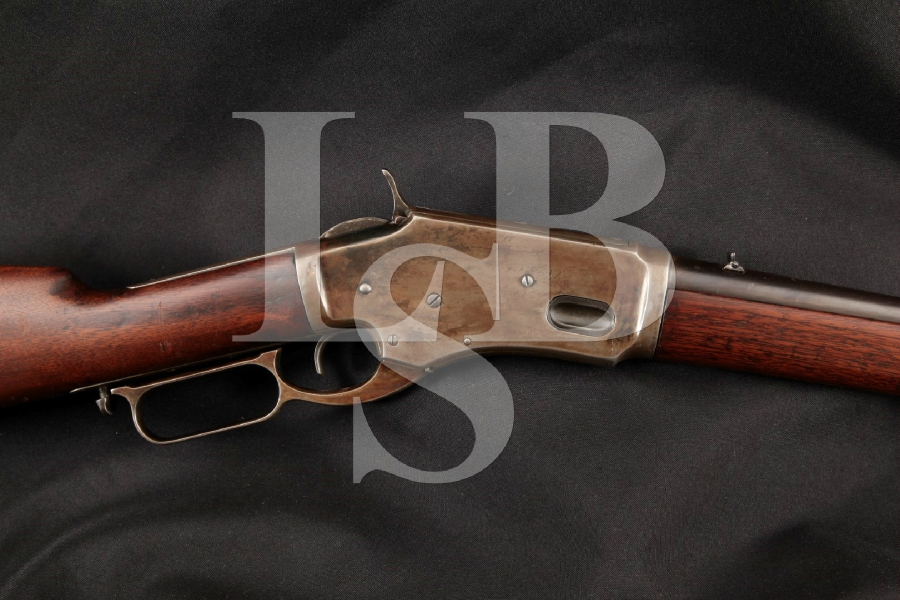
Whitney Arms Whitney-Kennedy Small Frame Saddle Ring Carbine, Loop Lever Model, Blue 20” Lever Action Tube Fed Rifle, MFD 1880-86 Antique
Sold For: $1,506.00
LSB#: 170107AL13
Make: Whitney Arms
Model: Whitney-Kennedy Small Frame Saddle Ring Carbine
Serial Number: J320
Year of Manufacture: 1880-1886 (http://www.eliwhitney.org/7/museum/permanent-installations/gun-collection/identifying-whitney-lever-action-guns)
Caliber: .44-40 Winchester
Action Type: Lever Action with Full Length Tubular Magazine
Markings: The top of the barrel is marked “WHITNEY KENNEDY MF D. BY / WHITNEY ARMS CO. NEW HAVEN, CT. U.S.A.” and at the receiver with “44 CAL”. The lower tang and the left side of the upper tang are marked “J320” and the side of the lever (inside receiver when closed) is marked “J / 320”.
Barrel Length: The round barrel is 20” in length.
Sights / Optics: The front sight is an inverted “V” fixed to the top of the barrel just behind the front barrel band. The rear sight is a folding “V” notch dovetailed into the top rear of the barrel.
Stock Configuration & Condition: The stocks are two piece walnut with a lacquered finish. The buttstock has a straight grip with a crescent shaped case colored buttplate. There is a brass trap door in the buttstock for storage of cleaning equipment. The forend is held with a single case colored barrel band. There was a repair made to the buttstock wherein a piece of walnut was inlet into the top of the comb just in front of the buttplate tang. There is also a crack at the rear left corner of the upper tang and a hairline crack at the rear right corner. There is a 2” long hairline crack on the right side of the buttstock at the butt, with a long scratch just above it. There are several dings in the belly and both sides of the wrists, with several small scratches and an abrasion on the sides of the buttstock. There is a ding in the right upper edge of the forend, a few dings in the left side of the forend and a hairline crack in its underside from the front edge of the forend to the barrel band. There is oil staining around the receiver, at the front of the comb and around the buttplate. The wood is shy of the metal around the upper tang. The LOP measures 12 ½” from the front of the trigger to the back of the buttplate. There is a plum colored patina forming on the buttplate, with light erosion under the patina. The edges of the heel and toe show light wear. The buttplate is in about Very Good condition. The stocks rate in about Good overall condition.
Type of Finish: The barrel and magazine tube are blued. The receiver, lever and lower tang have been refinished with cold bluing.
Finish Originality: We think the receiver, magazine tube, lever, tangs and forend barrel band were polished and then refinished with cold bluing. The finish on the barrel appears original. According to one reference, there should be patent dates on the upper tang, which are missing, and there are spots of pitting in the receiver under the cold bluing.
Bore Condition: The bore is bright with moderate wear in the rifling. There are tool marks in two of the grooves and one of the lands near the muzzle.
Overall Condition: This rifle retains about 10% of its metal finish. The barrel shows thinning with a plum colored patina formed over the thinned areas. The magazine tube shows areas of finish loss with light pitting under the blued finish. There is also a ding and several light scratches through the finish of the magazine tube. The front barrel band shows grind marks under the finish and tool marks around the screw head on the left side. The forend barrel band, receiver, lever, tangs, etc. appear to have been polished and then refinished with cold blue. They show a mottled plum colored finish with areas of dark bluing and spots of light pitting under the finish. The screw heads are mostly sharp, with one or two showing light marks from a screwdriver. The upper tang markings (patent dates) are missing, but the remaining marks are legible. Overall, this rifle rates in about Good condition.
Mechanics: The action functions correctly. The lever throw, while long, is extremely smooth, which is due in part to the way the bolt contacts the hammer as the lever is opened. The hammer has a quarter-cock safety notch. We have not fired this rifle. As with all used firearms, a thorough cleaning may be necessary to meet your maintenance standards.
Box, Paperwork & Accessories: A saddle ring is attached to the left side of the frame.
Our Assessment: In 1880, Samual V. Kennedy and Frank W. Tiesing redesigned the 1878 Whitney-Burgess-Morse rifle to accept the popular .44 Winchester Center Fire cartridge. With the basic machining already in place, the transition was rather inexpensive. The last Burgess was shipped from the factory in March 1880 and the first Kennedy was also shipped in March 1880. At about serial number 4500, the serial numbers were changed to a letter prefix, with about 23,500 rifles and carbines produced. Production ceased in early 1886, just two years before declining sales forced the sale of the company to Winchester. (http://www.eliwhitney.org/7/museum/permanent-installations/gun-collection/identifying-whitney-lever-action-guns). Only about 1000 were made in carbine configuration mixed between small and large frames, and most of the production was destined for South and Central America, never to be seen again here in the states. These carbines are therefore rare and highly sought after by collectors. This small-framed carbine is the later model with a loop lever, and is chambered in .44-40 Win. We think the receiver and magazine tube, as a minimum, were polished and refinished. The rifle is in about Good condition. The bore is bright with moderate wear in the rifling, but has a few tool marks near the muzzle. We think the collectors are going to be very interested in this saddle ring carbine.

